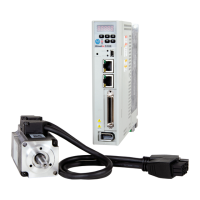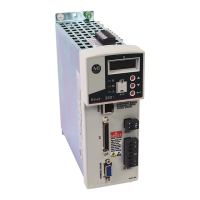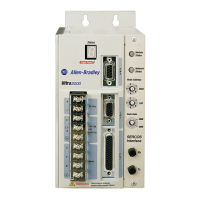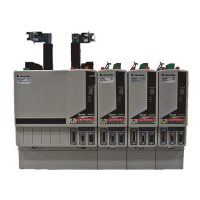Rockwell Automation Publication 2198-UM004A-EN-P - October 2019 399
Absolute Position Recovery Chapter 14
This table explains the delay time when reading the absolute position with DI/
DO.
Descriptions:
1. When handshake communication starts, the DI.ABSE signal is triggered.
2. After the T
S
delay time (make sure that the signal is on), the functions for
DI4, DO2, and DO3 are switched to the DI.ABSQ, the DO.ABSR, and
the DO.ABSD signals, respectively. If DI4 was in the high-level state
before, it remains in the high-level state when switched to the DI.ABSQ
signal (logic high-level signal). DI4, DO2, and DO3 are dual-function
DI/DO, which means DI4, DO2, and DO3 share the same digital input
with the DI.ABSQ signal, the DO.ABSR signal, and the DO.ABSD
signal. Use care when switching functions or setting the DI/DO to 0 to
disable the dual-function of DI/DO.
3. If DI4 is set to high and switched to the DI.ABSQ signal after the T
S
delay
time, when the host controller resets this signal to low, the new signal is
interpreted as the data access command.
4. After the T
Q
time, the handshake data is ready and the absolute position is
sent to the DO.ABSD signal. Now the servo drive turns on the DO.ABSR
signal, and the host controller can access the data. If the host controller still
cannot detect the DO.ABSR signal status while it is changing to high after
the maximum T
Q
time, there may be a communication error.
5. After the DO.ABSR signal is set high, the host controller accesses the data,
and the DI.ABSQ signal is set high to notify the servo drive that data was
read.
6. When the DI.ABSQ signal is high, the DO.ABSR signal is set low after
the T
N
time, to send the data for the next bit.
7. When the DO.ABSR signal is low, the DI.ABSQ signal is also set low and
the servo drive needs to send the data for the next bit.
8. Repeat step 3
… 4. Send the absolute position to the DO.ABSD signal for
the next bit communication.
9. Repeat step 5
… 7. The host controller has read and received the data.
10. The third bit data is ready.
11. After the T
R
waiting time, if the host controller has not read the data and
turned on the DI.ABSQ signal, the servo drive sends the DO.ABSW
signal (communication error) and stops the handshake communication.
12. When the host controller receives the communication error signal, the
DI.ABSE signal is set low and prepares to restart the handshake
communication.
T
R
(ms) T
S
(ms) T
Q
(ms) T
N
(ms) T
B
(ms)
Min - ID194 (P2.009) + 2
Max 200 ID194 (P2.009) + 10

